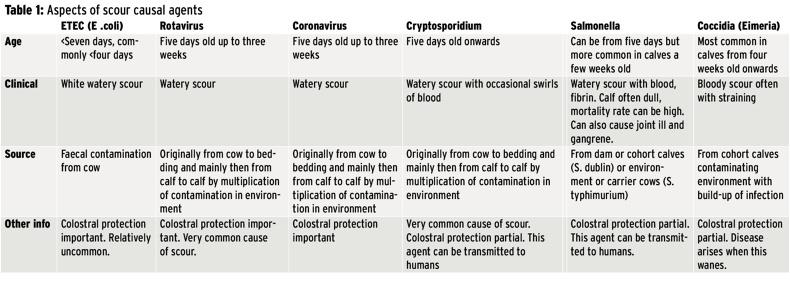Calf diarrhoea in the first three to four weeks of a calf’s life is the leading cause of calf mortality and economic loss for producers of beef and dairy calves (and has been for quite a number of years) in Ireland, according to Department of Agriculture, Food and the Marine statistics.
The costs of treatment or indeed preventive medicines are compounded by a list of other economic losses. These include reduced growth or production in later life, delayed development of affected calves, increased labour costs, the cost of dead calves, lost income from the potential sale of heifers that now have to be retained, a reduction in the rate of genetic improvement, and an increased risk of chemical residues in calves.
An overall scour control plan can be summarised in the word PICTURE. We will look at each of the aspects of this anagram individually as follows:
P – stands for prepare-prevent.
IC – Investigate cause.
T – Treat clinical cases.
U – Undertake further measures when causal agent is identified or deficiencies are discovered in controls.
R – Record incidents of scours, treatments and deaths to provide guidance on performance.
E – Evaluate performance with a view to improving the control plan.
Preparation and prevention (P)
If you have experienced scour problems in the past (or already this season), the key to future success is preparation. Pre-calving nutrition of cows influences the quality and quantity of colostrum produced. Colostrum production and subsequent management is a critical factor in the control of scours (See later). Seek advice from your vet or agricultural/nutritional adviser regarding dry cow nutrition, specifically concerning BCS, energy balance and minerals.
The next step is to address the environment into which the calf will land. Overcrowding, contamination, stress (thermal, if the calves are too cold), nutritional (calves underfed) or poor air quality (including draughts) can all contribute to a scour outbreak.
Address each of these issues in turn in your calf housing. Seek professional advice if necessary as an extra pair of eyes can identify shortcomings that may be overlooked by everyday exposure to the housing environment.
Identify cause (IC)
In order to understand how to best deal with a scour outbreak, it is important to briefly review the common causes of diarrhoea in calves of this age. There are a number of disease agents that have been consistently identified as significant causes of neonatal calf diarrhoea and mortality can range from 5% to 30%.
Treatment (T)
If calves become dehydrated, they become weak and shocked. While scour should not reach clinical proportions, if all management factors are correct, it is important to have an assigned hospital area to quickly and easily provide warmth (infra-red lamps) and comfort for clinical cases before the season starts. A useful strategy for dealing with the scoury calf is as follows:
Undertake further control measures (U)
Depending on the causal agent, it may be necessary to make changes. For instance, if coccidiosis is identified, the appropriate products for treatment must be selected, and for salmonellosis, antibiotics are necessary. For cryptosporidiosis or coccidiosis, disinfectants must be selected from a specific list as many are not effective against these agents. Consult your vet for advice in this regard. If problems arise, go back to the drawing board and examine where deficiencies have possibly arisen in preparation and prevention items listed above. If you have bought-in calves, did you buy in more than the calves? It is possible to identify possible sources of breakdown? For example, blood sampling of calves can identify if enough colostrum was given and early enough. Colostrum quality can also be assessed.
Record (R)
Always record all incidents of scour and treatment. This allows comparisons to be made from one season to the next. It allows evaluation of progress and identifies if controls are working (or not).
Evaluate performance (E)
Using the records for the season so far (or at the end of each calving period), look back on how you have done.
Are mortalities, treatments and case numbers improving or going in the wrong direction?
A trend identifies if further attention must be given to the P part of the picture.
A correctly tailored preventive programme that is constantly evaluated and improved has been shown to be very cost-effective, but it takes ongoing continuous effort.
